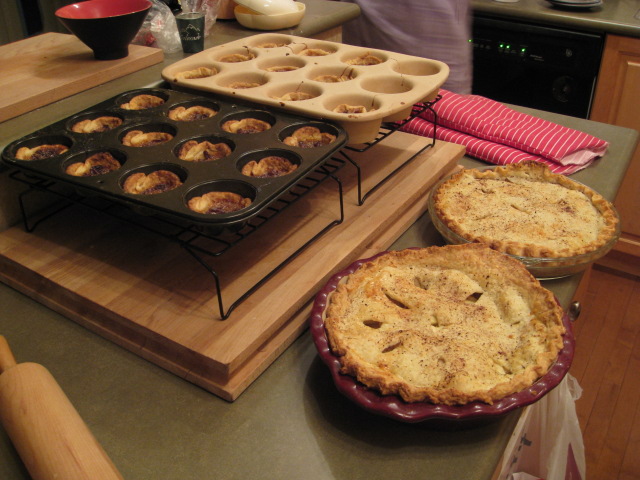The Mystery of the Melting Pie - Solved!
To quote Stephen Colbert, I Did It!
Oh yeah, I kinda went crazy. Two apple pies and two dozen butter tarts (using Linda’s delicious recipe… and boy, did they turn out fine). So, what happened? Well, allow me to ramble:
First off, understand that one of the reasons we make products with flour, and coincidentally one of the reasons celiacs hate it so much, is because of our good friend, gluten. Gluten is a protein present in wheat flour (and I’m assuming other grain flours, as well), and it is gluten which gives flour-based doughs their structure. Basically, when you introduce water to flour and start kneeding it, you liberate the gluten, which proceeds to create a little microscope network of protein strands. The result is a dough which is stretchy and, when baked, chewy (and delicious). Add yeast, baking soda, or some other leavening agent, and you get lift, as the gluten allows bubbles of carbon dioxide and steam to form in the dough.
But in the world of pastry, gluten is, generally speaking, your enemy. Gluten formation produces a pastry crust that’s chewy and tough, instead of flakey and light. As such, we do all sorts of things to discourage gluten development in pastry dough:
- Add only the minimal water necessary to bring the dough together.
- Avoid kneeding at all costs.
- Use a low-gluten pastry flour.
And it is that last item that was the key. In the world of flour, there’s all sorts of grades, separated by the amount of gluten present. Lowest to highest, we have:
- Cake flour
- Pastry flour
- All-purpose flour
- Bread flour
I’m sure there’s others in and around those, but those are the most common. Well, I went and bought a flour labelled “Cake and Pastry” flour. But which is it? Well, it turns out it’s the first (real pastry flour is actually pretty hard to come by in regular grocery stores). And there lies the key.
You know how I said gluten was a pastry-maker’s enemy? Well, that was a bit of a lie. You do need some gluten, otherwise those lovely, flakey layers can’t form. And more importantly, without gluten, the only thing holding the dough together is… the fat. And guess what? Fat melts in the oven. So a pastry dough with extremely low gluten levels will do just that: fall apart when the fat melts. Dough! (yes, that was a pun. Suck it up).
The solution? Well, I didn’t have all-purpose flour on-hand, so I used a 50% blend of cake and bread flour. Voila! Crust that held together (and tasted yummy!) So, remember, when making pastry, gluten is bad! Mostly.
-
{% for webmention in webmentions %}
-
{{ webmention.content }}
{% endfor %}
No bookmarks were found.
{% endif %}Likes
-
{% for webmention in webmentions %}
-
{% if webmention.author %} {% endif %}
{% endfor %}
-
{% for webmention in webmentions %}
-
{{ webmention.content }}
{% endfor %}
No links were found.
{% endif %}Replies
-
{% for webmention in webmentions %}
-
{% if webmention.author %} {% endif %} {% if webmention.content %} {{ webmention.content }} {% else %} {{ webmention.title }} {% endif %}
{% endfor %}
-
{% for webmention in webmentions %}
- {% endfor %}
-
{% for webmention in webmentions %}
- {% endfor %}
No reposts were found.
{% endif %}-
{% for webmention in webmentions %}
- {% endfor %}
No RSVPs were found.
{% endif %}-
{% for webmention in webmentions %}
-
{% if webmention.author %} {% endif %} {% if webmention.content %} {{ webmention.content }} {% else %} {{ webmention.title }} {% endif %}
{% endfor %}
No webmentions were found.
{% endif %}
